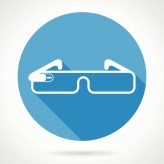
Advancements in medical technology allow doctors to provide better treatment and diagnosis to their patients. From electronic medical records to mobile devices, patients and physicians are reaping benefits from these new technologies. Additionally, a growing number of healthcare institutions are implementing Google Glass in their medical operations. Google Glass wasn’t originally designed for medical use, but many of its features allow for more efficient medical services.
What is Google Glass?
Google Glass is essentially a wearable computer with an optical head-mounted display. Glass has a small prism-like screen in the upper corner of the frame, which allows users to see and interact with information using a voice command system. Google Glass has a wide range of applications available to empower its functionality.
How Google Glass revolutionizes healthcare
Glass allows medical professionals to select and install healthcare applications. These applications are specially designed for medical usage, whether it’s to enable real-time access to patient information or to stream live video for educational purposes. Here are five ways Google Glass can enhance healthcare.
- EMS communication - During emergency patient transportation, Google Glass provides a connection between EMS ambulance staff and the emergency department team at a hospital. Glass allows paramedics to stream live images and videos from the ambulance to awaiting emergency room doctors, who can view the patient’s injury before arrival. Doctors are able to give initial treatment advice to paramedics. They can also prepare resources such as the operating room and medical equipment, in order to start treatment as soon as the patient arrives.
- Virtual dictation - According to a survey, doctors typically spend a third of their day on the computer, either to input or retrieve patients’ electronic medical records. Augmedix, a Google Glass application, eliminates these time-consuming processes and allows doctors to gain access to real-time patient data without being tethered to a computer. Doctors can communicate with their patients while browsing data via Glass by using simple voice commands.
- Patient care instruction - Every patient has different symptoms and medical needs. Healthcare staff with Glass can provide better treatment by viewing a patient’s medical records, what their families have had to say during medical consultations, and instructions from doctors. These recorded instructions ensure a patient’s safety, even if they are unable to recall their own care instructions.
- Procedure analysis - When it comes to medical services, it is simply not acceptable for patients to be negatively impacted by an error in the healthcare system. Google Glass enables medical staff to review emergency and operation procedures for training purposes. This improves accuracy for future procedures and also reduces the margin for error.
- Medical training assistance - Glass can literally walk medical students through surgical procedures. Doctors wearing Google Glass can project real-time visibility during surgical operations, giving the perfect point of view for observers. Glass can also record videos for future reference. This gives medical students or trainee staff far better insight into the whole procedure, rather than trying to view it from around a crowded operating table.
Google Glass is here to stay in the healthcare industry.

Leave a comment!
You must be logged in to post a comment.